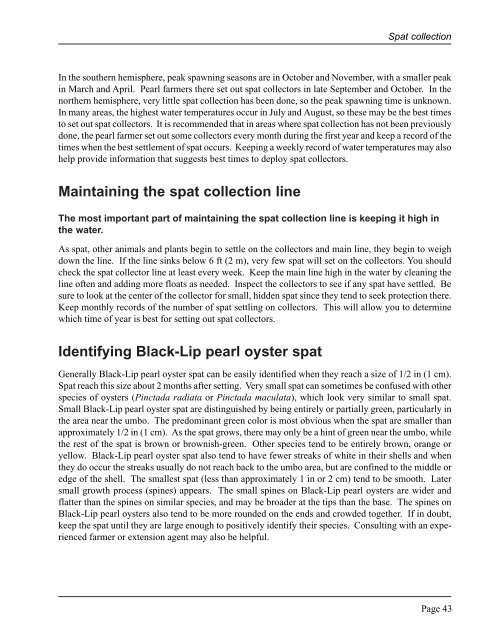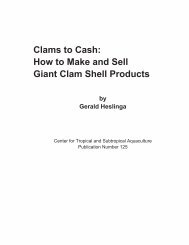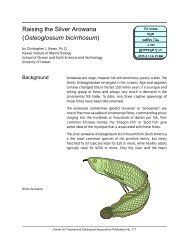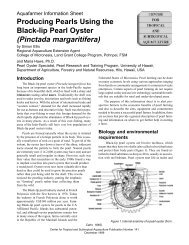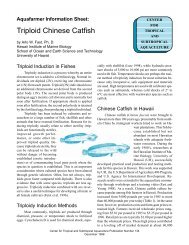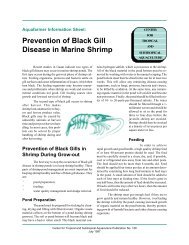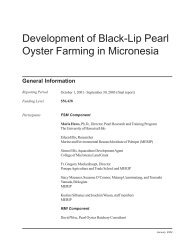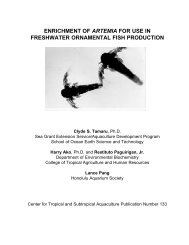The Basic Methods of Pearl Farming: A Layman's Manual - CTSA
The Basic Methods of Pearl Farming: A Layman's Manual - CTSA
The Basic Methods of Pearl Farming: A Layman's Manual - CTSA
You also want an ePaper? Increase the reach of your titles
YUMPU automatically turns print PDFs into web optimized ePapers that Google loves.
Spat collectionIn the southern hemisphere, peak spawning seasons are in October and November, with a smaller peakin March and April. <strong>Pearl</strong> farmers there set out spat collectors in late September and October. In thenorthern hemisphere, very little spat collection has been done, so the peak spawning time is unknown.In many areas, the highest water temperatures occur in July and August, so these may be the best timesto set out spat collectors. It is recommended that in areas where spat collection has not been previouslydone, the pearl farmer set out some collectors every month during the first year and keep a record <strong>of</strong> thetimes when the best settlement <strong>of</strong> spat occurs. Keeping a weekly record <strong>of</strong> water temperatures may alsohelp provide information that suggests best times to deploy spat collectors.Maintaining the spat collection line<strong>The</strong> most important part <strong>of</strong> maintaining the spat collection line is keeping it high inthe water.As spat, other animals and plants begin to settle on the collectors and main line, they begin to weighdown the line. If the line sinks below 6 ft (2 m), very few spat will set on the collectors. You shouldcheck the spat collector line at least every week. Keep the main line high in the water by cleaning theline <strong>of</strong>ten and adding more floats as needed. Inspect the collectors to see if any spat have settled. Besure to look at the center <strong>of</strong> the collector for small, hidden spat since they tend to seek protection there.Keep monthly records <strong>of</strong> the number <strong>of</strong> spat settling on collectors. This will allow you to determinewhich time <strong>of</strong> year is best for setting out spat collectors.Identifying Black-Lip pearl oyster spatGenerally Black-Lip pearl oyster spat can be easily identified when they reach a size <strong>of</strong> 1/2 in (1 cm).Spat reach this size about 2 months after setting. Very small spat can sometimes be confused with otherspecies <strong>of</strong> oysters (Pinctada radiata or Pinctada maculata), which look very similar to small spat.Small Black-Lip pearl oyster spat are distinguished by being entirely or partially green, particularly inthe area near the umbo. <strong>The</strong> predominant green color is most obvious when the spat are smaller thanapproximately 1/2 in (1 cm). As the spat grows, there may only be a hint <strong>of</strong> green near the umbo, whilethe rest <strong>of</strong> the spat is brown or brownish-green. Other species tend to be entirely brown, orange oryellow. Black-Lip pearl oyster spat also tend to have fewer streaks <strong>of</strong> white in their shells and whenthey do occur the streaks usually do not reach back to the umbo area, but are confined to the middle oredge <strong>of</strong> the shell. <strong>The</strong> smallest spat (less than approximately 1 in or 2 cm) tend to be smooth. Latersmall growth process (spines) appears. <strong>The</strong> small spines on Black-Lip pearl oysters are wider andflatter than the spines on similar species, and may be broader at the tips than the base. <strong>The</strong> spines onBlack-Lip pearl oysters also tend to be more rounded on the ends and crowded together. If in doubt,keep the spat until they are large enough to positively identify their species. Consulting with an experiencedfarmer or extension agent may also be helpful.Page 43


